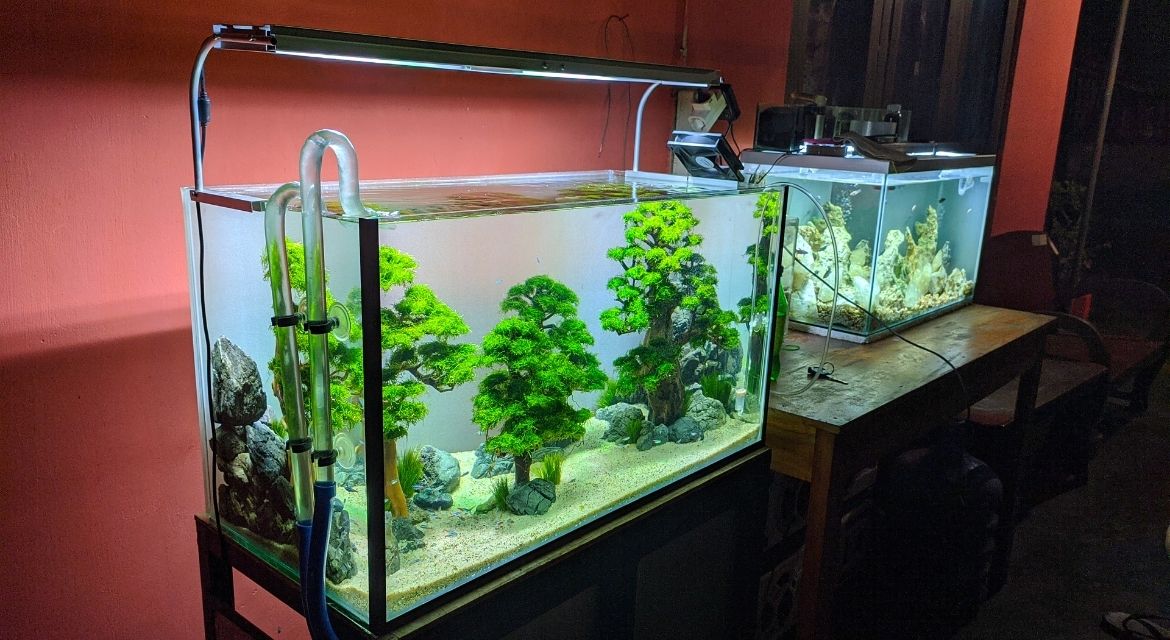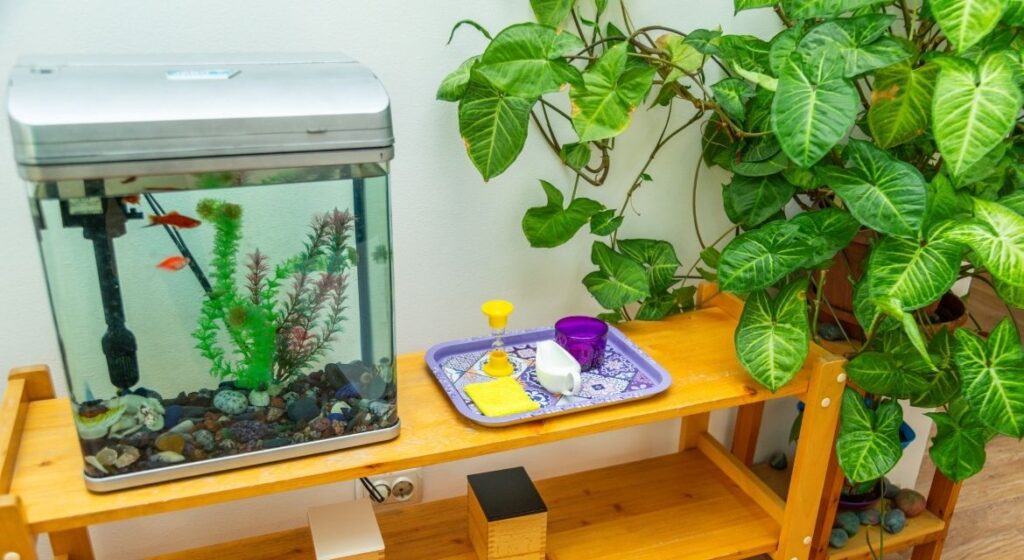 21 May
21 MayComplete Aquarium Setup for Beginners: The Ultimate Guide to Creating a Thriving Fish Tank
Table of Contents
Are you considering diving into the wonderful world of fishkeeping? An aquarium setup for beginners can be an exciting yet challenging endeavor. While the idea of having a vibrant underwater ecosystem in your home is appealing, creating and maintaining a healthy environment for aquatic life requires knowledge, patience, and proper planning. This comprehensive guide will walk you through everything you need to know about aquarium setup for beginners, from selecting the right tank to maintaining a thriving ecosystem.
Understanding the Basics of Aquarium Setup for Beginners
Beginning your journey into fishkeeping starts with understanding what makes a successful aquarium setup for beginners. A proper setup is more than just filling a tank with water and adding fish it’s about creating a balanced ecosystem where fish, plants, and beneficial bacteria can coexist harmoniously.
Why Proper Planning Matters
Many new aquarists rush into the hobby without adequate preparation, leading to common problems like fish stress, disease outbreaks, and even death. A well-planned aquarium setup for beginners prevents these issues by establishing a stable environment from the start. When your tank is properly set up, you’ll enjoy:
- Healthier, longer-living fish
- Reduced maintenance time and effort
- Fewer water quality problems
- A more visually appealing display
- Less money spent on replacing fish or equipment
Taking the time to research and properly execute your aquarium setup for beginners will save you frustration, time, and resources in the long run.
Choosing the Right Aquarium for Your Space and Needs
The foundation of any successful aquarium setup for beginners is selecting the appropriate tank. This decision will influence every other aspect of your setup, from equipment requirements to the types of fish you can keep.
Types of Aquariums: Pros and Cons
Glass Aquariums
Glass tanks are the traditional choice for aquarium setup for beginners. They offer several advantages:
- More affordable than acrylic options
- Resistant to scratching
- Maintain clarity over time
- Provide excellent viewing with minimal distortion
However, glass tanks also have disadvantages:
- Heavier than acrylic alternatives
- More prone to cracking or breaking
- Limited shape options (usually rectangular)
- Visible seams at the edges
Acrylic Aquariums
For a modern aquarium setup for beginners, acrylic tanks provide:
- Lightweight construction (about half the weight of glass)
- Greater impact resistance
- Seamless construction for improved aesthetics
- Available in various shapes and designs
- Better insulation properties
The drawbacks of acrylic include:
- Higher cost than glass
- Susceptibility to scratches
- Potential yellowing over time with UV exposure
- May bow slightly under pressure with larger sizes
Rimless and Cube Aquariums
These contemporary options add style to an aquarium setup for beginners:
- Rimless tanks offer unobstructed viewing without plastic frames
- Cube tanks maximize vertical space in small areas
- Both provide a modern, minimalist aesthetic
- Work well as focal points in room design
Size Considerations for Your First Aquarium
When planning your aquarium setup for beginners, tank size is crucial. Contrary to popular belief, larger tanks are often better for novices. Here’s why:
Benefits of Larger Tanks (30-55 Gallons)
- More stable water parameters due to larger water volume
- Greater margin for error with water quality
- More space for fish to grow and thrive
- Opportunity to keep a wider variety of species
- Room to expand your collection gradually
Challenges of Smaller Tanks (Under 20 Gallons)
- Rapid water parameter fluctuations
- Limited stocking options
- Higher maintenance requirements
- Greater risk of overcrowding
- Less room for equipment
For most beginners, a 20-29 gallon tank represents a good compromise between manageability and stability, making it an ideal choice for an initial aquarium setup for beginners.
Strategic Location Selection
The placement of your tank is a critical factor in your aquarium setup for beginners that’s often overlooked. Consider these factors when choosing a location:
Structural Support
- Ensure your floor can support the weight (a filled 20-gallon tank weighs approximately 225 pounds)
- Use a dedicated aquarium stand designed for the weight
- Place the tank against a load-bearing wall if possible
- Ensure the surface is perfectly level to prevent stress on tank seams
Environmental Factors
- Avoid direct sunlight, which promotes algae growth and causes temperature fluctuations
- Stay away from heating/cooling vents that create temperature instability
- Keep distance from doors, windows, and high-traffic areas to reduce vibration
- Consider proximity to electrical outlets for equipment
- Ensure there’s enough space for maintenance access (at least 6 inches behind the tank)
Aesthetic Integration
- Choose a location visible from primary seating areas
- Consider how the tank will complement your existing décor
- Ensure the tank doesn’t block pathways or inhibit room function
- Account for potential water splashes during maintenance
Essential Equipment for Aquarium Setup for Beginners
A successful aquarium setup for beginners requires specific equipment to maintain water quality and create a suitable environment for aquatic life. Let’s explore each component in detail.
Filtration Systems: The Heart of Your Tank
Filtration is arguably the most critical element of an aquarium setup for beginners. Filters perform three essential functions:
Mechanical Filtration
- Removes physical debris and particles from water
- Uses foam, sponges, or filter floss to trap waste
- Requires regular cleaning to prevent clogging
Chemical Filtration
- Removes dissolved waste products and impurities
- Typically uses activated carbon or specialized resins
- Helps eliminate odors and discoloration
Biological Filtration
- Cultivates beneficial bacteria that process toxic waste
- Converts harmful ammonia to less harmful nitrates
- Crucial for the nitrogen cycle that sustains your aquarium
Types of Filters for Beginners
Hang-on-Back (HOB) Filters
- Easy installation and maintenance
- Relatively affordable
- Good combination of all three filtration types
- Suitable for most standard aquarium setup for beginners
- Space-efficient design
Canister Filters
- Higher capacity for larger or heavily stocked tanks
- Increased media capacity for customized filtration
- Quieter operation than many alternatives
- Located outside the tank for a cleaner look
- More thorough filtration but higher cost
Sponge Filters
- Gentle flow suitable for fry and small species
- Simple design with few moving parts
- Excellent biological filtration
- Very affordable option
- Requires an air pump to operate
Internal Filters
- Compact and fully submersible
- Good for smaller tanks
- No risk of leaks outside the aquarium
- Easy to conceal behind decorations
- Limited capacity compared to external options
When selecting a filter for your aquarium setup for beginners, choose one rated for at least 1.5 times your tank’s volume. This ensures adequate filtration even as waste accumulates between cleanings.
Heating Systems: Maintaining Optimal Temperature
Unless you’re keeping coldwater species like goldfish, most aquarium fish require heated water. A reliable heater is crucial for an aquarium setup for beginners with tropical fish.
Heater Types
Submersible Heaters
- Fully waterproof for complete submersion
- Can be positioned horizontally or vertically
- Even heat distribution throughout the tank
- Most common choice for aquarium setup for beginners
Hanging Heaters
- Older style that hangs from the tank rim
- Partially submerged with controls above water
- Less efficient than modern submersible models
- Lower risk of cracking during water changes
In-line Heaters
- Connected to external filter plumbing
- Keeps equipment out of the main tank
- Provides even heating through filter outflow
- More advanced option not typically used in an aquarium setup for beginners
Heater Selection Guidelines
- Choose a heater with approximately 5 watts per gallon of water
- For tanks over 30 gallons, consider using two smaller heaters instead of one large one
- Always select a heater with an adjustable thermostat
- Include a separate thermometer to verify temperature (don’t rely solely on the heater’s settings)
- Position the heater near water circulation for even heat distribution
Lighting Systems: Illuminating Your Underwater World
Proper lighting is essential for any aquarium setup for beginners, affecting both aesthetics and the health of your tank inhabitants.
Lighting Functions in the Aquarium
- Showcases the beauty of fish, plants, and decorations
- Promotes plant growth if you have live plants
- Helps maintain normal day/night cycles for fish
- Creates a focal point in your room
Lighting Options
LED Lighting
- Energy-efficient with low operating costs
- Long lifespan (often 50,000+ hours)
- Low heat production
- Available in various colors and intensities
- Many models offer customizable settings
- Ideal for most aquarium setup for beginners
Fluorescent Lighting
- Traditional option with moderate efficiency
- Good plant growth for moderate-light species
- Affordable initial cost
- Bulbs require replacement every 6-12 months
- Higher heat output than LEDs
High-Output Lighting
- Necessary only for advanced planted tanks
- More expensive and energy-intensive
- Produces significant heat
- Generally not needed for a basic aquarium setup for beginners
When selecting lighting for your first tank, consider a basic LED system with a timer to ensure consistent light cycles. For most beginners, 8-10 hours of light per day is suitable.
Substrate: Creating the Foundation
The substrate is the material lining the bottom of your tank, and it serves several important functions in an aquarium setup for beginners:
Functions of Substrate
- Provides aesthetic appeal and natural appearance
- Creates a home for beneficial bacteria
- Anchors live plants and decorations
- Can influence water chemistry
- Offers behavioral outlets for substrate-sifting fish
Substrate Options
Gravel
- Traditional choice for aquarium setup for beginners
- Available in various colors and sizes
- Easy to clean with a gravel vacuum
- Allows waste to filter through to be removed during maintenance
- Relatively inexpensive
Sand
- Creates a natural look for many biotopes
- Better for bottom-dwelling fish that sift or dig
- Shows waste on the surface for easy removal
- Compacts more than gravel, requiring occasional stirring
- Can cause problems if drawn into filter intakes
Plant-Specific Substrates
- Contain nutrients for healthy plant growth
- Often include clay components or enriched materials
- Higher cost than standard substrates
- May alter water parameters (often lowering pH)
- Better choice if you plan a planted aquarium setup for beginners
For a standard aquarium setup for beginners, aim for 1-2 inches of substrate. For planted tanks, 2-3 inches provides adequate rooting depth for most species.
Decorations and Aquascaping
Decorations do more than make your tank attractive they create territories and hiding places essential for fish health and natural behavior.
Natural Decorations
- Driftwood adds a natural element and may release beneficial tannins
- River stones and rocks create structures and territories
- Live plants provide oxygen and help process waste
- Clay pots and caves offer shelter for shy species
Artificial Decorations
- Ceramic ornaments provide consistent coloration
- Plastic plants require no maintenance
- Resin structures offer elaborate designs without the risk of affecting water chemistry
- Silicone decorations provide soft edges for delicate fish
When planning decorations for your aquarium setup for beginners, create multiple hiding spots while leaving open swimming areas. Arrange taller items toward the back and sides to enhance the perception of depth.

Water Quality Management for Beginners
Water quality is the single most important factor in a successful aquarium setup for beginners. Understanding and maintaining proper water parameters will prevent most common problems.
Understanding Water Parameters
Essential Parameters to Monitor
- Ammonia (NH3/NH4+): Should always be 0 ppm; toxic even in small amounts
- Nitrite (NO2-): Should always be 0 ppm; highly toxic to fish
- Nitrate (NO3-): Should be below 20-40 ppm; less toxic but harmful at high levels
- pH: Typically 6.5-8.0 depending on fish species; stability is more important than exact value
- Temperature: Usually 75-80°F (24-27°C) for tropical communities
- General Hardness (GH): Measures dissolved minerals; requirements vary by species
- Carbonate Hardness (KH): Measures water’s buffering capacity; helps stabilize pH
Essential Water Treatment Products
Your aquarium setup for beginners should include these water treatment essentials:
Water Conditioner
- Removes chlorine and chloramine from tap water
- Many also detoxify heavy metals
- Some products offer protective colloids for fish slime coats
- Must be used with every water addition to the tank
Biological Supplements
- Contain beneficial bacteria to help establish the nitrogen cycle
- Useful during tank cycling and after maintenance
- Can help recover from filtration problems
- Not a substitute for proper cycling but can expedite the process
Testing Equipment
- Liquid test kits offer greater accuracy than test strips
- At minimum, test for ammonia, nitrite, nitrate, and pH
- Record results to track changes over time
- Essential for troubleshooting problems in your aquarium setup for beginners
Setting Up Your Aquarium Step-by-Step
Now that you understand the components, let’s walk through the process of establishing your aquarium setup for beginners from start to finish.
Initial Setup Phase
Step 1: Preparation and Planning
- Research fish species you’d like to keep
- Calculate the appropriate tank size
- Purchase all necessary equipment
- Prepare your chosen location
Step 2: Install the Tank
- Clean the tank with water only (never use soap or detergents)
- Place the tank on a sturdy, level surface
- Install background if desired
- Test fill with water briefly to check for leaks, then empty
Step 3: Add Substrate and Hardscape
- Rinse substrate thoroughly to remove dust
- Add a layer of substrate 1-3 inches deep depending on your plans
- Position larger decorations and hardscape elements
- Create structures and hiding places
Step 4: Install Equipment
- Position heater according to manufacturer instructions
- Install filter and ensure proper flow
- Add thermometer on the opposite side from the heater
- Set up lighting system
Step 5: Fill the Tank
- Place a plate or plastic bag on the substrate
- Pour water slowly onto the plate to avoid disturbing the substrate
- Fill to about 80% capacity
- Add water conditioner according to package directions
Step 6: Start Equipment
- Plug in filter and verify proper operation
- Set heater to desired temperature (typically 76-78°F for community tanks)
- Check for any leaks or equipment issues
- Leave lighting off initially to prevent algae growth
The Cycling Process: Establishing Biological Filtration
Before adding fish to your aquarium setup for beginners, you must cycle the tank to establish beneficial bacteria. This nitrogen cycle converts toxic ammonia from fish waste into less harmful compounds.
Cycling Methods
Fishless Cycling (Recommended)
- Add an ammonia source (pure ammonia, fish food, or organic matter)
- Test ammonia levels until they reach 2-4 ppm
- Continue testing every other day
- When nitrites appear, you’ve started the cycle
- Continue until ammonia and nitrites both read 0 ppm
- When the tank can process 2-4 ppm of ammonia to 0 within 24 hours, it’s cycled
Time frame: 3-6 weeks for complete cycling
Benefits of fishless cycling for aquarium setup for beginners:
- No risk to live fish
- Can establish stronger bacterial colonies before adding stock
- Allows higher initial stocking once complete
- More humane approach to establishing your tank
Cycle Monitoring
- Use liquid test kits for accurate readings
- Test every 2-3 days during cycling
- Track results to observe the progression
- Perform water changes if nitrites exceed 5 ppm
Introducing Fish to Your New Aquarium
Once your aquarium setup for beginners is fully cycled, you can begin adding fish. This process should be gradual and carefully managed.
First Fish Selection
The best first fish for your aquarium setup for beginners should be:
- Hardy and adaptable to varying water conditions
- Peaceful community species
- Small to medium size
- Active swimmers that will bring the tank to life
Recommended Beginner Fish:
- Zebra Danios
- Platies
- Corydoras Catfish
- Harlequin Rasboras
- Black Skirt Tetras
- Guppies (males mix well; females may breed rapidly)
Acclimation Process
To minimize stress when adding fish to your aquarium setup for beginners:
- Float the closed bag in your tank for 15-20 minutes to equalize temperature
- Open the bag and add a small amount of tank water every 5-10 minutes
- After 30 minutes, gently net the fish and transfer to your tank
- Discard the bag water rather than adding it to your tank
- Keep lights dimmed or off for several hours after introduction
Stocking Guidelines
Follow these principles for stocking your aquarium setup for beginners:
- Add fish gradually over weeks, not all at once
- Begin with 25-30% of your tank’s eventual capacity
- Test water parameters before and after adding new fish
- Wait at least one week between adding new fish
- Research each species’ compatibility and space requirements
Ongoing Maintenance for Aquarium Setup for Beginners
A successful aquarium setup for beginners requires regular maintenance to remain healthy. Establishing a maintenance schedule is essential.
Weekly Maintenance Tasks
Water Changes
- Change 10-25% of water weekly
- Use a gravel vacuum to remove waste from substrate
- Always treat new water with conditioner
- Match temperature of new water to tank temperature
Water Testing
- Test ammonia, nitrite, nitrate, and pH weekly
- Record results to track trends
- Take corrective action if parameters shift
Visual Inspection
- Check fish for signs of disease or stress
- Inspect equipment for proper operation
- Look for algae buildup
- Observe fish behavior and appetite
Monthly Maintenance Tasks
Filter Maintenance
- Rinse mechanical media in removed tank water (never tap water)
- Replace chemical media as recommended
- Never clean all biological media at once
- Check impeller and moving parts
Deep Cleaning
- Scrape algae from glass
- Prune plants if present
- Clean decorations as needed
- Inspect seals and connections
Equipment Check
- Verify heater accuracy
- Clean filter intakes and outputs
- Check air pump operation if used
- Calibrate testing equipment if necessary
Feeding Guidelines for Beginners
Proper feeding is a critical but often overlooked aspect of aquarium setup for beginners. Many new aquarists overfeed, leading to water quality problems.
Basic Feeding Principles
- Feed only what fish can consume in 2-3 minutes
- Typically feed once or twice daily
- Provide one fasting day per week
- Vary diet with high-quality flakes, pellets, frozen, and freeze-dried foods
- Remove uneaten food promptly
Troubleshooting Common Problems in New Aquarium Setups
Even with careful planning, issues can arise in your aquarium setup for beginners. Here’s how to identify and address common problems:
Water Clarity Issues
Cloudy White Water
- Cause: Bacterial bloom, often during cycling or after adding new fish
- Solution: Be patient, ensure proper filtration, avoid overfeeding, consider partial water change
Green Water
- Cause: Algae bloom, usually from excess light or nutrients
- Solution: Reduce lighting duration, perform water changes, consider adding live plants
Yellow or Tea-Colored Water
- Cause: Tannins from driftwood or botanical elements
- Solution: Activated carbon in filter, increased water changes, or simply wait as it’s harmless
Fish Health Problems
Gasping at Surface
- Cause: Low oxygen levels or ammonia/nitrite poisoning
- Solution: Test water immediately, increase aeration, perform water change
Lethargy or Loss of Appetite
- Cause: Poor water quality, disease, or incorrect temperature
- Solution: Test water parameters, check heater, observe for visible signs of illness
White Spots on Fish (Ich)
- Cause: Common parasite, often triggered by stress
- Solution: Raise temperature gradually to 86°F if fish can tolerate it, use appropriate medication, continue treatment for 2 weeks
Equipment Failures
Heater Malfunction
- Cause: Mechanical failure, incorrect settings, or poor positioning
- Solution: Replace faulty equipment, always use a separate thermometer to verify temperature
Filter Issues
- Cause: Clogging, impeller problems, or power failure
- Solution: Regular cleaning, backup battery-operated air pump for emergencies
Advanced Tips for Enhancing Your Beginner Aquarium Setup
Once you’ve mastered the basics of aquarium setup for beginners, consider these enhancements:
Live Plants for Beginners
Adding live plants to your aquarium setup for beginners offers numerous benefits:
- Natural filtration of waste products
- Oxygen production
- Algae prevention through nutrient competition
- Aesthetic enhancement
- Stress reduction for fish
Easy Beginner Plants:
- Java Fern (attaches to decorations, doesn’t need substrate)
- Anubias (very low light requirements)
- Amazon Sword (good background plant)
- Java Moss (versatile, can cover any surface)
- Marimo Moss Balls (technically algae, extremely hardy)
Automated Systems
Consider these time-saving additions to your aquarium setup for beginners:
- Automatic feeders for short trips away
- Smart power strips that protect equipment during power surges
- Timers for consistent lighting cycles
- Auto-top-off systems to maintain water level
Moving Beyond the Basics
As you gain confidence with your aquarium setup for beginners, you might explore:
- Species-specific tanks (such as biotope aquariums)
- Breeding projects for livebearers or egg-scatterers
- Advanced aquascaping techniques
- Specialized water parameters for exotic species
Conclusion: Your Journey in Aquarium Keeping
Creating a successful aquarium setup for beginners is a rewarding endeavor that combines science, art, and patience. By following the comprehensive guidelines in this article, you’re well-positioned to establish a healthy, vibrant underwater ecosystem that will bring joy for years to come.
Remember that every aquarium setup for beginners faces some challenges, but with proper planning, consistent maintenance, and ongoing learning, you’ll develop the skills to overcome these obstacles. The aquarium hobby offers endless opportunities for growth and exploration as your experience expands.
Take your time with each step of the process, resist the urge to rush, and enjoy watching your aquatic world develop. With the foundation of knowledge provided in this guide to aquarium setup for beginners, you’re ready to embark on a fascinating journey into the wonderful world of fishkeeping.
Happy fishkeeping, and enjoy your new aquarium setup for beginners!
You May Also Like :
How to Stop Dog Barking: The Complete Guide to a Quieter, Happier Pet
Comprehensive Guide to Interactive Cat Toys: Keeping Indoor Cats Happy and Healthy
Dog Grooming at Home: The Complete Guide for Dog Owners
10 Essential Dog Training Tips Every New Puppy Owner Should Know
How to Take Care of a Pet: Essential Guide to Responsible Pet Ownership
The Ultimate Guide to Cat Playtime: Why Play Is Essential for Your Feline’s Health and Happiness
How to Successfully Work from Home with Pets: A Comprehensive Guide
The Mental Health Benefits of Having a Dog: What Every Pet Owner Should Know
How to Groom a Puppy for the First Time: Step-by-Step Guide
Quick Solutions for Daily Pet Care: Simple Strategies for a Happier Pet and Easier Routine




